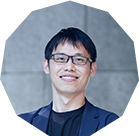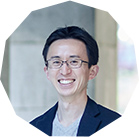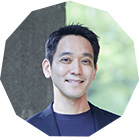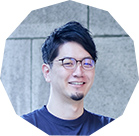HR SUPPORT
- HOME
- HR SUPPORT
- HR INTERVIEW BionicM Inc.
HR INTERVIEW
PROLOGUE
The world of prosthetic limbs is about to change. Conventional prostheses are passive, replicating the functions of bones and joints. Since the prostheses are not powered they would put strain on the other parts of the body when moving or cause an event called "knee buckling", which makes a fall very likely. To solve this problem, the powered prosthesis developed by BionicM Inc. was designed to assist natural human movement by adding the functions of "muscles and nerves" to conventional prosthesis. We interviewed Dr. Xiaojun Sun, the CEO of BionicM on how he built his management team along with the Director and COO Mr. Teppei Sekiguchi, Mr. Keisuke Ide Partner at UTEC and external board member at BionicM, and Mr. Hirofumi Oki, UTEC HR senior manager.
TALK MEMBER
-

BionicM Inc. CEO
Sun Xiaojun
-

BionicM Inc. COO
Teppei Sekiguchi
-

UTEC Partner
Keis Ide
-

UTEC HR
Senior ManagerHirofumi Oki
SECTION 1 Powered Prosthetic Limbs from Asia to Global Market
Dr. Sun is a prosthetic limb user himself, who had always felt the difficulty of using prosthetic limbs. We interviewed him about how he started his business, as well as his first encounter with UTEC.
- How did you come about developing powered prosthetic limbs?
Sun
I’m from China, and I had my left limb amputated when I was nine years old due to a disease. It was after I came to Japan as an exchange student that I first started using a prosthetic limb. I was so grateful to have both hands free to increase my activity level without the need of crutches. However, I still found a lot of challenges in my life with a prosthetic limb. So I quit Sony where I was working and started doing research and development of powered prosthetic limbs.
There was only one powered prosthesis in the world at the time, and it was developed mainly for injured soldiers. This device is always in one mode, which is full power, so the user needs to be physically strong, and must have practice to adjust and adopt to the motor characteristics of the prosthesis. What we are developing is a type of prosthesis that uses various sensing technologies so that prosthesis adjusts and adopts to the user, not vice versa. Instead of the user trying to adapt to the prosthesis, the prosthesis adapts to the user.
- How did you first meet UTEC?
Sun
I started my PhD program at the University of Tokyo in October 2015. I wanted to apply for the Japan Science and Technology Agency (JST)'s "Program for Creating Start-ups from Advanced Research and Technology (START)" to get funding for my research, but this program requires not only researchers but also venture capitals to pair up to apply. When I raised my hand saying I wanted to apply, Mr. Ide took notice of me. That’s how we got talking.
Ide
When I first saw his proposal, I thought it was an interesting fusion of humanoid technology and ergonomics. But START is a 3-year program. If we were to do this together, I would also be spending a good amount of time on it, so I needed to discuss with the UTEC team in a process similar to our investment committee.
When we looked into the feasibility of the project in terms of business, we found that the global market for prosthetic limbs is about 100-200 billion yen per year, but three companies from Europe and North America already had an oligopoly, making it difficult to create competition, and prices remained high. On top of that, no major manufacturers were present in Asia. In additionIn terms of regulatory environment, prosthetic limbs are considered as medical devices in Europe and North America, but in Japan and China, which are the main Asian markets, they are categorized as supportive equipment similar to a wheel chair, making it easier for startups to enter the market. We determined that the project had a high business potential, so we decided to support the project, three years before the company was eventually incorporated.
SECTION 2 You Can’t Run a Company Alone
Dr. Sun started the development with a total of three members who were engineers and designers, but in order to launch a business, it is essential to have a business-minded management talent. UTEC matched the company with Mr. Sekiguchi, the current COO.
- Would you tell us how you first met Mr. Sekiguchi?
Sun
I had three years of working experience at Sony, but since I was an engineer, I had very little experience doing business. Even if the development goes well, there is a risk that the product fails in commercialization unless there is someone who can drive the business. Mr. Ide also advised me "You can’t manage a company alone. It’s important to create a team,” so I was looking for the right candidate.
Ide
The first time we met was through the UTEC Venture Partner Program (UVPP), which matches technically-oriented researchers with business-minded candidates to develop startups together. There were five startup companies (including pre-startup projects), and we assigned four candidates for each startup, so a total of twenty participants were involved, and Mr. Sekiguchi was one of them.
Sekiguchi
Back then, I was working for P&G. It is a great company, but household product is a mature market, so it lacked the feeling of challenge from a business perspective. This was when I saw the announcement of UVPP on Facebook and joined the group.
First, I saw the presentation of all the researchers, then I selected Dr. Sun's project as my first choice. There were two reasons to this. First one was that Dr. Sun seemed to be committing his life into the project. Another one was the size of the challenge to be tackled. The household products I was dealing with at the time would have many alternatives by other manufacturers even if the company I worked for did not produce them. In contrast, I felt there are many people in the world who have problems with the fundamental human activity of walking, and there is literally no solution to these problems. Dr. Sun's powered prosthesis can be the solution. I made Dr. Sun’s project my first choice because I thought this was a project that was worth putting my life for. However, perhaps because I majored in a study related to agriculture, I was assigned to an agritech startup instead of Dr. Sun's team (laughs).
Sun
That’s right. But Mr. Ide secretly told me that Mr. Sekiguchi's first choice was my team, so we exchanged contact information at the end of the program. Since then, we have been in touch with each other.
- Did the joining of Mr. Sekiguchi go smoothly?
Sun
I completed my PhD in August 2018, and was planning to start my business in October. In the meantime, I have been in contact with Mr. Sekiguchi, working on nights and weekends together to do things like market research and updating our website. So there was a growing mutual feeling of wanting to start a business together.
Ide
We counted on Mr. Sekiguchi's participation for the seed round investment, so we really wanted him to be a part the company. However, for a talented person like Mr. Sekiguchi, a transition from a renowned multinational corporation like P&G to a seed stage startup is one major life decision. I also told Dr. Sun, “You will be asking him to make a major decision of his life. Are you ready to take on this responsibility?”
Sekiguchi
I personally didn’t have any problems. But we just had a baby, so my wife seemed quite worried. I remember creating PowerPoint slides and did a presentation to my wife, as if I was going to present to my investors (laughs).
It was April 2019 that I officially joined the company. My first role was Director of Business Administration to execute the business. But in reality, early days of a startup meant there were virtually no sections. I did everything including miscellaneous tasks, from buying stationery to getting a phone line set up in the office.
Sun
Mr. Sekiguchi was helpful in every way, but the most significant was in the area of management. Back then, I didn't even know what a one-on-one meeting was or how to do it. If Mr. Sekiguchi had not come and created a system to drive the team along, the company wouldn't have been able to survive.
SECTION 3 Enhancing Organizational Structure for IPO
BionicM had accelerated its business through the seed round investment led by UTEC. With further support the Company is building its team and product to enter a new phase of the startup.
SECTION 3 Enhancing Organizational Structure for IPO
BionicM had accelerated its business through the seed round investment led by UTEC. With further support the Company is building its team and product to enter a new phase of the startup.
- How did the HR team of UTEC support BionicM?
Oki
In the early days of a startup, members of all levels work in a broad and variety of fields. However, ideally, it is best to have each person focus on their own expertise. So first, we drew an ideal organization chart together for each milestone and identified the areas that BionicM were missing. Designating priorities, we supported in the recruiting process.
Sekiguchi
It was very helpful that UTEC’s HR team provided advice in details, like "the job description in such wording would be difficult for agents to understand the requirements", in addition to the overall strategy. Thanks to this, we are now a team of 18 people with various expertise.
Ide
Speaking of management talent, the addition of Mr. Cheng Tao, CEO of popIn Inc. as an independent external director was a significant factor. Venture capitals and entrepreneurs work together to drive the business, but naturally there are times when they split in an opinion. I wanted to have an independent outside director who was not a shareholder or founder, who could give us more objective advice in such cases. So, I asked Mr. Cheng, the CEO of UTEC's former portfolio company and a man I trust and admire, to join us.
Sun
When I heard about the need for an independent external director, the first person that came to my mind was Mr. Cheng. One of UTEC's strengths is that it has a network of executives whom they could ask to serve as external directors. In addition to the monthly board meetings, we often went out for yakiniku BBQ together. Even when we were eating Mr. Cheng gave us advice on marketing.
- How do you see your future prospects?
Sun
This year, we will finally be able to launch the powered prosthesis we have developed. As we promote and sell the product, we plan to IPO in about two to three years to fulfill our responsibility to our investors. Beyond that, we will realize our mission, "Powering Mobility For All." What we are currently working on are prosthetic limbs for the physically challenged, but we plan to extend our technology to enhance mobility for all persons.
Ide
The mission is exactly in line with what we envisioned when we invested in the company. As a venture capital fund, we can provide direct support to the Company only up to the timing of IPO. However, the Company creates value to the society far beyond the timing of IPO, and we realize the team we support to create now is going to be the essence of the company long after public listing. Funding is a tool to create the business and the organization, which are both scrutinized for integrity and growth perspectives prior to the IPO. It is essential to build a strong organization, so I intend to continue to support BionicM in cooperation with our HR team.
-
HR INTERVIEW
WASSHA, Inc.
-
HR CROSS TALK
HR Team Talk